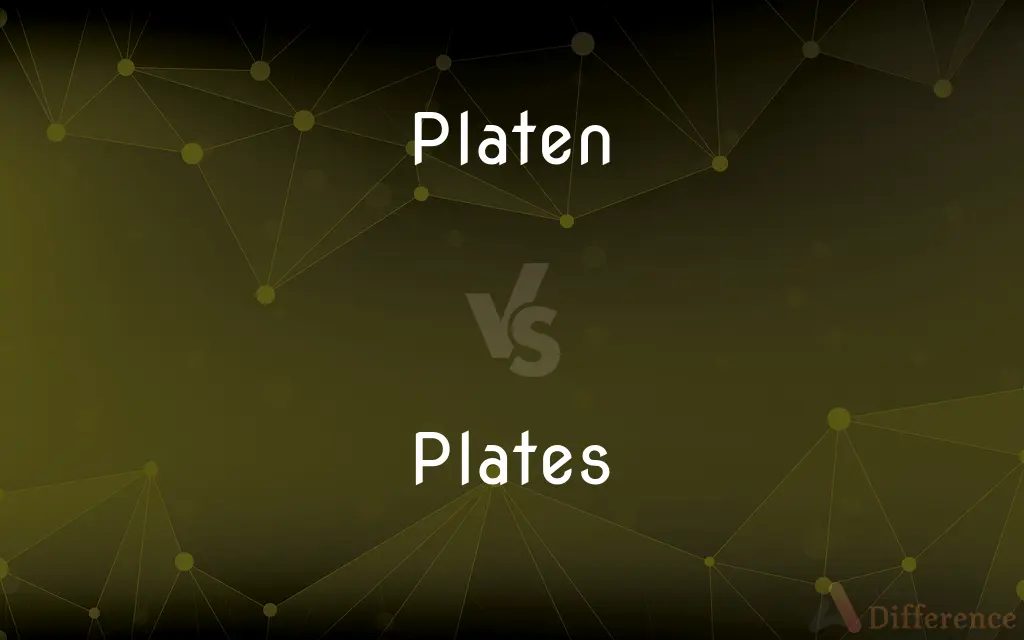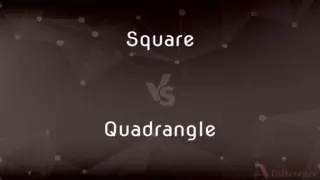Platen vs. Plates — What's the Difference?
Edited by Tayyaba Rehman — By Urooj Arif — Updated on April 4, 2024
A platen is a flat platform supporting or compressing materials, whereas plates are flat dishes from which food is eaten.

Difference Between Platen and Plates
Table of Contents
ADVERTISEMENT
Key Differences
A platen refers to a part of a machine designed to press or support materials during processing, often found in printers, embossing machines, or hydraulic presses. It's engineered to apply even pressure or support to materials, ensuring precise operations in various industrial, printing, and manufacturing applications. On the other hand, plates are a staple in households and dining establishments worldwide, serving as the base from which people eat meals.
While a platen plays a critical role in the functionality of equipment by ensuring materials are held firmly and evenly for processes like printing, lamination, or pressing, plates are selected based on aesthetic preferences, the type of meal being served, and cultural norms. Platens are evaluated for their durability, material compatibility, and ability to distribute pressure or heat, whereas plates are chosen for their design, material safety for food, and ease of cleaning.
Platens are integral to the operations of machinery in which they are installed, often requiring specific materials like steel or silicone to withstand pressure, heat, or chemical exposure. In contrast, plates are available in a wide range of materials, each offering different benefits: porcelain for elegance, stainless steel for durability, or bamboo for sustainability.
In industrial and manufacturing settings, the maintenance and selection of a platen are crucial for ensuring product quality and machine longevity. Regular maintenance, appropriate selection, and sometimes customization are necessary to meet specific operational requirements. Conversely, plates require simpler care, such as regular washing, and rarely need customization, except in cases of branding or personal preference.
Though platens and plates serve vastly different functions—one in machinery, the other in dining—their importance to their respective fields is undeniable. Platens ensure the precision and efficiency of mechanical processes, while plates play a key role in the presentation and enjoyment of food.
ADVERTISEMENT
Comparison Chart
Primary Function
To press or support materials in machinery.
To serve food.
Material
Metals, silicone, composite materials.
Ceramic, metal, plastic, glass, bamboo.
Usage Context
Industrial, printing, manufacturing.
Household, dining, culinary.
Importance
Ensures precision and quality in processes.
Facilitates food presentation and consumption.
Maintenance & Care
Requires specific maintenance for longevity.
Simple cleaning, occasional replacement.
Compare with Definitions
Platen
A heated plate used for thermal processing.
The platen's temperature was carefully controlled during the lamination process.
Plates
A flat dish for serving or eating food.
She set the table with the new porcelain plates for dinner.
Platen
A part of a machine that holds material in place.
The hydraulic press's platen exerted uniform pressure across the surface.
Plates
A thin piece of metal used in orthopedics.
The surgeon secured the bone with a titanium plate during the operation.
Platen
The metal plate in a typewriter that holds the paper steady.
She adjusted the platen to align the paper before typing.
Plates
A shallow dish used in laboratories.
Samples were placed in petri plates for observation.
Platen
A flat plate in a printing press that presses the paper against the type.
The platen must be evenly coated to ensure high-quality prints.
Plates
A metal plate used for engraving.
The artist etched the design onto the plate before printing.
Platen
The flat surface on a 3D printer where objects are built.
The model was carefully removed from the platen after printing.
Plates
A decorative piece often hung on walls.
The antique plate collection was displayed prominently in the dining room.
Platen
A platen (or platten) is a flat platform with a variety of roles in printing or manufacturing. It can be a flat metal (or earlier, wooden) plate pressed against a medium (such as paper) to cause an impression in letterpress printing.
Plates
A smooth, flat, relatively thin, rigid body of uniform thickness.
Platen
The roller in a typewriter that serves as the backing for the paper against which the type bars strike.
Plates
A sheet of hammered, rolled, or cast metal.
Platen
The roller in a printer against which the print head strikes.
Plates
A very thin applied or deposited coat of metal.
Platen
A flat plate or rolling cylinder in a printing press that positions the paper and holds it against the inked type.
Plates
A flat piece of metal forming part of a machine
A boiler plate.
Platen
The glass surface of a flatbed scanner.
Plates
A flat piece of metal on which something is engraved.
Platen
(printing) The part of a printing press which presses the paper against the type and by which the impression is made.
Plates
A license plate
A car with Utah plates.
Platen
The part of a typewriter or printer on which the paper rests to receive an impression.
Plates
A thin piece of metal used for armor.
Platen
The movable table of a planer or other machine tool, on which the work is fastened, and presented to the action of the tool.
Plates
Armor made of such pieces.
Platen
The flat glass surface of a scanner or photocopier on which operators place items to be scanned.
Plates
A sheet of metal, plastic, rubber, paperboard, or other material prepared for use as a printing surface, such as an electrotype or a stereotype.
Platen
The part of a printing press which presses the paper against the type and by which the impression is made.
Plates
A print of a woodcut, lithograph, or other engraved material, especially when reproduced in a book.
Platen
Work table of a machine tool
Plates
A full-page book illustration, often in color and printed on paper different from that used for text pages.
Platen
The flat plate of a printing press that presses the paper against the type
Plates
(Photography) A light-sensitive sheet of glass or metal on which a photographic image can be recorded.
Platen
The roller on a typewriter against which the keys strike
Plates
(Dentistry) A thin metallic or plastic support fitted to the gums to anchor artificial teeth.
Plates
(Architecture) In wood-frame construction, a horizontal member that bears a load, as of a roof or a wall.
Plates
(Baseball) Home plate.
Plates
A shallow dish in which food is served or from which it is eaten.
Plates
The contents of such a dish
Ate a plate of spaghetti.
Plates
A whole course served on such a dish.
Plates
Service and food for one person at a meal
Dinner at a set price per plate.
Plates
Household articles, such as hollowware, covered with a precious metal, such as silver or gold.
Plates
A dish passed among the members of a group or congregation for the collection of offerings.
Plates
A dish, cup, or other article of silver or gold offered as a prize.
Plates
A contest, especially a horserace, offering such a prize.
Plates
A thin cut of beef from underneath the ribs, including the diaphragm muscle.
Plates
A thin flat layer or scale, as that of a fish.
Plates
A platelike part, organ, or structure, such as that covering some reptiles.
Plates
An electrode, as in a storage battery or capacitor.
Plates
The anode in an electron tube.
Plates
(Geology) See tectonic plate.
Plates
(Informal) A schedule of matters to be dealt with
Had a lot on my plate at work after vacation.
Plates
To coat or cover with a thin layer of metal.
Plates
To cover with armor plate
Plate a warship.
Plates
(Printing) To make a stereotype or electrotype from.
Plates
To give a glossy finish to (paper) by pressing between metal sheets or rollers.
Plates
To arrange (food) on a plate, as for serving
"a choice of starters, entrées, and desserts plated just as they will appear when ordered" (John Edward Young).
Plates
(Baseball) To cause (a run) to be scored or (a runner) to cross home plate, as by a hit.
Plates
Plural of plate
Common Curiosities
What is a platen used for?
A platen is used in machines to press, support, or hold materials during various processes like printing or embossing.
What are the common materials used to make plates?
Common materials include ceramic, metal, plastic, glass, and bamboo.
What materials are platens made from?
Platens are typically made from metals, silicone, or composite materials, depending on their specific application.
Why is the material of a platen important?
The material affects the platen's durability, heat resistance, and suitability for specific processes.
How does the design of a platen affect its function?
Design impacts how effectively a platen presses, supports, or heats materials, crucial for the outcome of the process it's used in.
What factors influence the choice of plates for a meal?
Factors include the type of meal, aesthetic preferences, cultural norms, and the material’s safety for food use.
Can platens be customized?
Yes, platens can be customized for specific industrial processes, sizes, or material requirements.
How do you maintain a platen?
Maintenance involves regular cleaning, checking for wear or damage, and ensuring it is correctly aligned and functioning.
Can plates be used for anything other than eating?
Yes, plates can also serve decorative purposes, as in wall hangings, or in specialized applications like printing or scientific research.
Is it important to match plates during a meal?
While not essential, matching plates can enhance the dining experience and presentation of the meal.
Why might someone choose bamboo plates over ceramic?
Bamboo plates offer sustainability and a lightweight option, whereas ceramic plates provide durability and elegance.
Are there different types of plates for different foods?
Yes, plates vary in size and design, with specific types like soup plates or dessert plates tailored to different foods.
Can the condition of a platen affect the quality of a machine’s output?
Yes, the condition of a platen can significantly impact the precision, quality, and overall outcome of the machine’s operation.
What role does a platen play in 3D printing?
In 3D printing, the platen provides a flat surface on which the object is built layer by layer.
How do decorative plates differ from dining plates?
Decorative plates often feature intricate designs and are used for aesthetic purposes, while dining plates are designed for practical food service.
Share Your Discovery

Previous Comparison
Square vs. Quadrangle
Next Comparison
Howling vs. BarkAuthor Spotlight
Written by
Urooj ArifUrooj is a skilled content writer at Ask Difference, known for her exceptional ability to simplify complex topics into engaging and informative content. With a passion for research and a flair for clear, concise writing, she consistently delivers articles that resonate with our diverse audience.
Edited by
Tayyaba RehmanTayyaba Rehman is a distinguished writer, currently serving as a primary contributor to askdifference.com. As a researcher in semantics and etymology, Tayyaba's passion for the complexity of languages and their distinctions has found a perfect home on the platform. Tayyaba delves into the intricacies of language, distinguishing between commonly confused words and phrases, thereby providing clarity for readers worldwide.














































